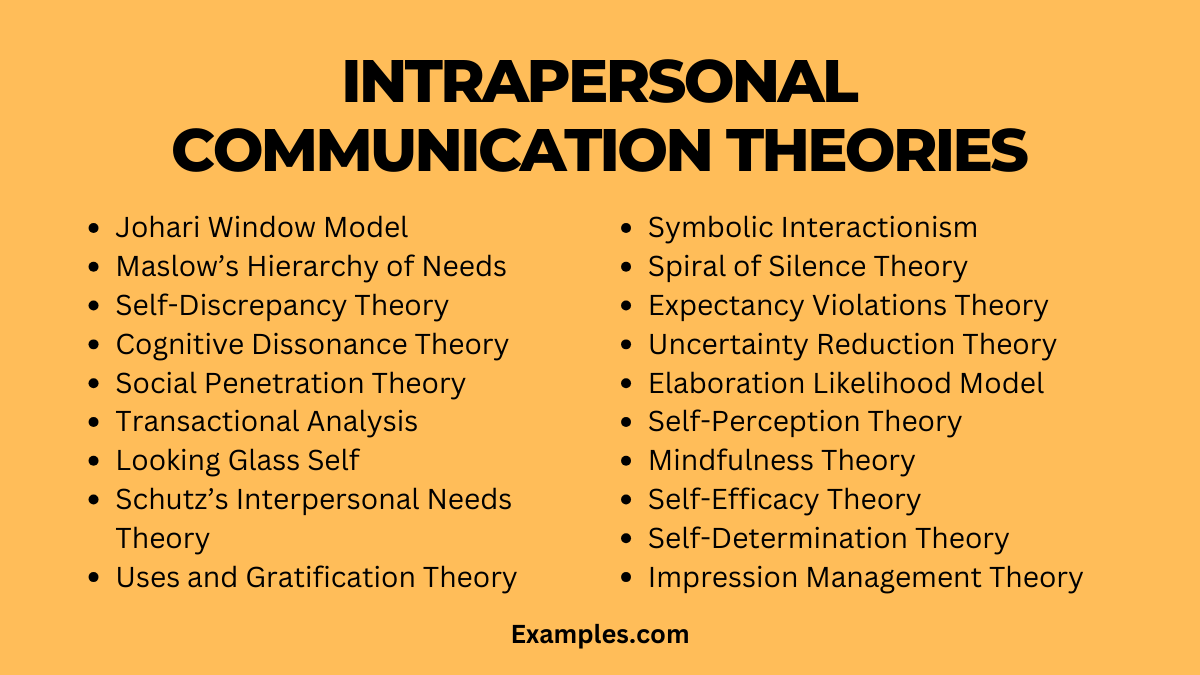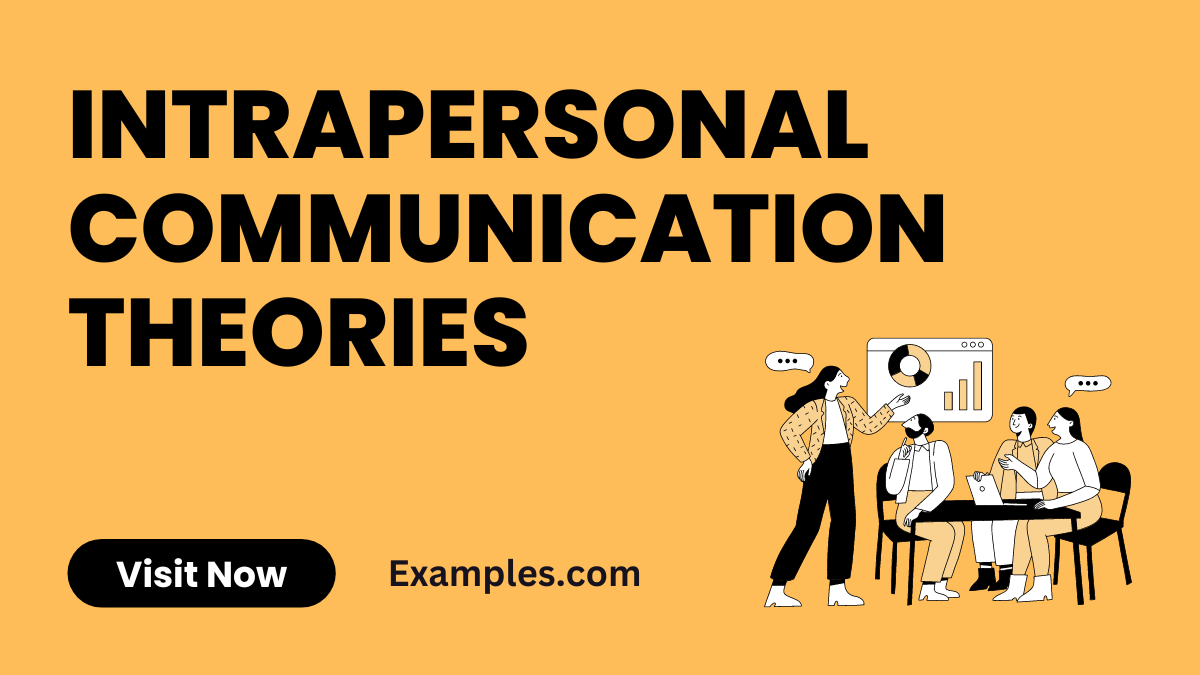Intrapersonal Communication Theories
Intrapersonal Communication Theories offer invaluable insights into the complex process of communicating with oneself. These theories explore the dynamics of self-talk, self-awareness, and internal reasoning, playing a crucial role in personal growth and decision-making. Understanding these theories is key to mastering the art of intrapersonal communication, facilitating a deeper connection with oneself, improved mental well-being, and more effective interactions in daily life.
List of Intrapersonal Communication Theories

Intrapersonal Communication Theories provide a deep understanding of the internal processes influencing how we think, feel, and communicate with ourselves. These theories range from psychological frameworks to models explaining self-perception and internal dialogue. They are essential in exploring self-awareness, decision-making, and personal growth, offering insights into how we process and respond to information internally.
Johari Window Model:
Reveals known and unknown aspects of self. The Johari Window Model, created by Joseph Luft and Harrington Ingham, is a psychological tool used to enhance self-awareness and improve interpersonal relationships through four quadrants of self-knowledge.
Example: “Understanding my open and hidden areas helps me communicate better with myself and others.”
Maslow’s Hierarchy of Needs:
Prioritizes human needs from basic to self-fulfillment. Maslow’s Hierarchy of Needs is a psychological theory proposing five levels of human needs, from basic physiological needs to self-actualization, influencing motivation and personal growth.
Example: “My focus on career growth aligns with my esteem and self-actualization needs.”
Self-Discrepancy Theory:
Explores the gap between actual, ideal, and ought self. Self-Discrepancy Theory This theory, developed by Higgins, explores the impact of discrepancies between one’s actual, ideal, and ought selves on emotions and self-esteem.
Example: “I often assess the gap between who I am and who I aspire to be.”
Cognitive Dissonance Theory:
Addresses the discomfort from conflicting beliefs or behaviors. Cognitive Dissonance Theory Leon Festinger’s theory focuses on the discomfort felt when holding conflicting beliefs, leading individuals to alter attitudes or beliefs to reduce discomfort.
Example: “Feeling uneasy about my choices often signals a cognitive dissonance I need to resolve.”
Social Penetration Theory:
Describes the development of deeper self-understanding. Social Penetration Theory Developed by Altman and Taylor, this theory describes how interpersonal relationships develop through gradual layers of self-disclosure and vulnerability.
Example: “Delving into my deeper thoughts and feelings helps me understand myself better.”
Transactional Analysis:
Analyzes the ego states as a framework for understanding behavior. Transactional Analysis Created by Eric Berne, this psychological theory analyzes human social interactions and communication through a model of parent, adult, and child ego states.
Example: “Recognizing my ‘parent’, ‘adult’, and ‘child’ ego states explains a lot about my internal dialogue.”
Looking Glass Self:
Suggests that self-perception is influenced by how others perceive us.Looking Glass Self Theory Cooley’s theory suggests that a person’s self-concept is shaped largely by how they believe others perceive them.
Example: “I sometimes see myself through others’ eyes, which affects my self-esteem.”
Schutz’s Interpersonal Needs Theory:
Applies to intrapersonal context in understanding personal needs. Schutz’s Interpersonal Needs Theory William Schutz’s theory proposes that interpersonal relationships are formed and sustained based on three fundamental needs: inclusion, control, and affection.
Example: “My need for inclusion influences how I interact with others and perceive myself.”
Uses and Gratification Theory:
Explores how individuals actively seek out media to fulfill needs. Uses and Gratification Theory This theory suggests that people actively seek out media to fulfill specific needs like entertainment, information, personal identity, and social integration.
Example: “I choose specific books and shows that satisfy my emotional and intellectual needs.”
Narrative Theory:
Looks at how individuals use stories to make sense of their experiences. Narrative Theory Focuses on the way people make sense of experiences by structuring them into stories, impacting perception and communication.
Example: “Telling my story, even to myself, helps me understand my life’s events better.”
Symbolic Interactionism:
Views the self as a reflection of societal expectations and interactions. Symbolic Interactionism A sociological perspective that views human behavior as constructed through communication and interpretation of symbolic meanings.
Example: “I often think about how societal norms shape my behavior and self-concept.”
Spiral of Silence Theory:
Relates to how individuals silence themselves to avoid disapproval. Spiral of Silence Theory Proposes that individuals remain silent on their minority views due to fear of social isolation.
Example: “I sometimes hold back my opinions when I feel they’re unpopular, affecting my self-expression.”
Expectancy Violations Theory:
Deals with how people react to unexpected actions of others. Expectancy Violations Theory Examines how people respond when their interpersonal expectations are violated, positively or negatively.
Example: “When someone reacts unexpectedly, I introspect on my expectations and perceptions.”
Uncertainty Reduction Theory:
Explains how individuals seek information to reduce uncertainty. Uncertainty Reduction Theory Focuses on how human communication is used to gain knowledge and reduce uncertainty.
Example: “In unfamiliar situations, I internally analyze to reduce my uncertainty and anxiety.”
Elaboration Likelihood Model:
Describes the different ways individuals process persuasive information. Elaboration Likelihood Model Explains how people are persuaded, distinguishing between central and peripheral routes of persuasion.
Example: “I often find myself deeply analyzing persuasive arguments, aligning with the central route of processing.”
Self-Perception Theory:
Suggests people infer their attitudes by observing their own behavior. Self-Perception Theory Suggests that people develop attitudes by observing their own behavior and concluding what attitudes must have caused it.
Example: “Reflecting on my actions helps me understand my true feelings and beliefs.”
Mindfulness Theory:
Focuses on being fully present and aware in the moment. Mindfulness Theory Emphasizes being fully present and engaged in the moment, enhancing self-awareness and mental well-being.
Example: “Practicing mindfulness, I engage deeply with my current thoughts and feelings.”
Self-Efficacy Theory:
Centers on an individual’s belief in their ability to succeed. Self-Efficacy Theory Centers on an individual’s belief in their ability to succeed in specific situations or accomplish tasks.
Example: “Believing in my abilities, I boost my self-efficacy and tackle challenges confidently.”
Self-Determination Theory:
Looks at motivation in terms of autonomy, competence, and relatedness. Self-Determination Theory This theory focuses on motivation, suggesting that people have innate psychological needs for competence, autonomy, and relatedness.
Example: “Understanding my need for autonomy helps me make choices that align with my personal values.”
Impression Management Theory:
Involves how people attempt to influence the perceptions of others and themselves. Impression Management Theory Describes how individuals attempt to control the impressions others form of them in social interactions.
Example: “I’m aware of how I try to influence how others, and sometimes I, perceive myself.”
Each theory provides a unique lens through which Intrapersonal Communication can be understood, offering valuable insights into self-awareness, personal growth, and internal processing.
Intrapersonal Communication Theories offer invaluable insights into the complexities of internal dialogue and self-awareness. This guide has highlighted a variety of theories, each shedding light on different aspects of personal communication and thought processes. Understanding these theories is crucial for enhancing self-awareness, improving decision-making, and fostering personal growth, making them indispensable tools for anyone looking to deepen their understanding of themselves and their interactions with the world.



